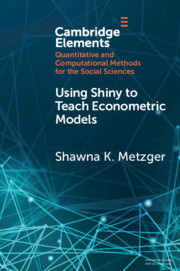Element contents
Using Shiny to Teach Econometric Models
Published online by Cambridge University Press: 01 May 2021
Summary
- Type
- Element
- Information
- Online ISBN: 9781108883993Publisher: Cambridge University PressPrint publication: 20 May 2021
References
- 8
- Cited by



